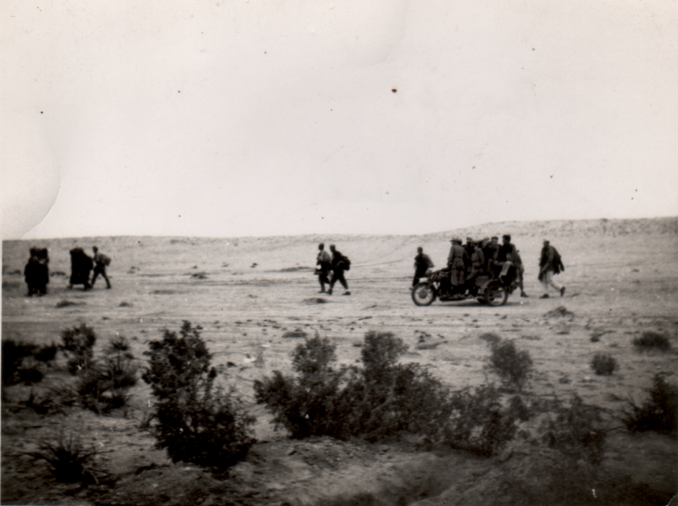
Previously unpublished photo courtesy of DJM’s uncle David, © 2021
The Axis forces will surrender in May so April sees the Allies squeezing the Axis into a smaller and smaller area.
On the 1st the US 1st and 9th Infantry Divisions attacked Italian positions at Hill 369 near El Guettar, Tunisia for the third consecutive day with little success.
On the 2nd Near El Guettar, Tunisia, US 9th Infantry Division was moved to attack Hill 772; its original objective of Hill 369 was now left to US 1st Infantry Division to capture. Allied bombers conducted raids across Italy, hitting Messina, Crotone, Villa San Giovanni, Naples, Augusta, and Palermo. Some of the missions were aborted due to cloud cover.
On the 3rd US 1st Infantry Division captured Hill 369 near El Guettar, Tunisia.
On the 4th Unable to do it himself, George Patton ordered Omar Bradley to fire Orlando Ward of the 1st Armoured Division for Ward’s failures at Kasserine Pass, Tunisia. Ward was the only General who was fired during the Tunisian Campaign.
On the 5th the Allies launched Operation Flax, a concentrated effort to destroy the Axis’s capability to supply Tunisia by air. USAAF 325th Fighter Group received orders to move two of its P-40 squadrons to the airfield at Montesquien, Algeria.
On the 6th Axis forces fell back from Wadi Akarit towards Enfidaville, Tunisia as the British Eighth Army began linking up with US II Corps. British pressure in southeastern Tunisia caused Axis forces to begin falling back from the El Guettar region. When a company of the British 5th East Yorkshire Regiment had to withdraw temporarily behind the crest of a hill in southern Tunisia, Private Eric Anderson, a stretcher-bearer, went forward alone through heavy fire to rescue the wounded. Three times he brought in wounded comrades, and was rendering first aid to a fourth when he was mortally wounded. For this gallant deed on the field of battle, Private Anderson would be awarded a posthumous Victoria Cross.
On the 7th Hitler and Mussolini began a four-day meeting near Salzburg, Austria trying to keep Italy in the war. This led to a month of meetings with Axis allies for pep talks to keep them active against the Allies. British and American troops linked up on the El Guettar-Gabès road in Tunisia, ending the Battle of El Guettar. USAAF 325th Fighter Group saw its first combat mission as 36 of its P-40 fighters escorted a group of B-25 bombers to attack Mateur in Tunisia; one P-40 fighter was lost during this mission.
On the 8th The British submarine HMS Unshaken (Lieutenant Whitton) torpedoed and sank the 1,227-ton Italian merchant steamer Foggia 10 miles from Sousse, Tunisia. The Foggia was previously the French vessel Mont St. Clair.
On the 9th British troops captured Mahares, Tunisia.
On the 10th the Allies continued Operation Flax offensives over the seas between Sicily, Italy and Tunisia destroying many Axis transport aircraft and fighters. On the ground, British troops captured Sfax, Tunisia. 84 American B-24 bombers attacked Sardinia, Italy, sinking one cruiser and damaging another.
On the 11th The Germans lost several transport aircraft flying between Sicily and Tunisia. On the ground, Allied troops captured Kairouan, Tunisia.
On the 12th the RAF Desert Air Force assumed leadership roles in Operation Flax in North Africa. On the same day, troops of British 8th Army captured Sousse, Tunisia.
On the 13th US bombers attacked Italian airfields at Castelvetrano and Trapani in Sicily, destroying 11 Italian and 8 German aircraft and damaging 16 Italian and 40 German aircraft, at the cost of only 2 B-17 bombers.
On the 14th the remnants of “Tobruch” Battalion of the “San Marco” naval infantry regiment of Italian Navy began to arrive in Italy from Tunisia.
On the 15th RAF bombers conducted a raid on La Spezia, Italy.
On the 16th 13 British Spitfire fighters intercepted a large Axis air convoy off Tunisia, shooting down 7 SM.82 and 1 Bf 109 aircraft at the cost of only 2 Spitfire fighters. Italians raised the wreck of Foch at Toulon, France for repair.
On the 17th US bombers attacked Palermo in Sicily. German pilots who scrambled to meet the attackers claimed they shot down 5 bombers and 1 fighter.
On the 18th 47 P-40 and 12 Spitfire fighters intercepted a large Axis air convoy off Tunisia, shooting down 24 German transport aircraft, 10 German fighters, and some Italian fighters. So many lives were lost that the Germans dubbed the action Palm Sunday Massacre.
On the 20th British troops captured the Enfidaville Airfield in Tunisia.
On the 21st New Zealand troops of Maori ethnicity captured Takrouna, Tunisia. Troops of 48th Battalion of British Royal Tank Regiment captured German Tiger I heavy tank “131” near Medjez-el-Bab, Tunisia.
On the 22nd South African and British fighters intercepted an Italian air convoy off Tunisia and claimed to have shot down 12 transport aircraft and 7 escorts. On the ground, the final Allied assault began against the remaining Axis forces in North Africa with armoured thrusts from Sidi Nsir, Medjez, and Pont du Fahs. Only at Enfidaville was there a halt. Resistance remained fierce, however, and was professionally handled by the Germans and Italians, allowing units of the Luftwaffe to be evacuated from the shrinking perimeter.
On the 24th In the Mediterranean Sea, British submarine HMS Sahib (Lieutenant Bromage) was scuttled and abandoned by her crew to avoid capture after being seriously damaged by the Italian torpedo boat Climene. Her loss would be officially announced by the Admiralty on 6 May 1943.
On the 29th German troops fell back to Lake Garaet Anchkel west of Bizerte, Tunisia; the “Grado” Battalion of the “San Marco” naval infantry regiment of the Italian Navy served as rearguard
In other news – on the 12th the British War Office circulated the “German Long-Range Rocket Development” report, which warned of great danger from these potential new weapons, on the 14th the No. 3 Column of the Chindits crossed the Chindwin River in Burma and soon became the first column to return to India, on the 16th came the first night fighter attack on London carried out by thirty Focke-Wulf 190 aircraft, it turned into a farce, only two bombs hit the city, and four German pilots got lost, thought that they were over France and landed at West Malling RAF fighter base in Kent where three were taken prisoner and one was killed crash-landing, on the 17th Adolf Hitler met with Hungarian regent Miklós Horthy in an attempt to persuade him to further the attempt to deport Jews, who were “pure parasites” and compared to “tuberculosis bacilli” according to Hitler, out of Hungary, Horthy would continue to comply with this deportation request as little as possible, on the 19th HMS Seraph departed Holy Loch in Scotland with the body of Glyndwr Michael, dressed as Major William Martin and planted with false documents intended to mislead the Germans as to where the next landings would take place, on the 20th the British government announced a limited recruitment for women for the Home Guard, on the 21st an attempt was made to assassinate General Charles de Gaulle when the Wellington bomber flying him to Glasgow was sabotaged at RAF Hendon, the pilot detected the elevator controls had been cut just before take-off and aborted the flight, at the time the incident was hushed up and blamed on German intelligence but de Gaulle never flew by plane in Britain again, on the 23rd Orde Wingate and his small group of Chindits spotted the Chindwin River in Burma from a high spot; they were about 30 miles away from the river, on the 26th the No. 5 Column of the Chindits arrived in Imphal, India, only 95 men of the original force of 318 returned, on the 27th Orde Wingate and his small group of Chindits reached the Chindwin River in Burma. They were able to cross it later in the day with the help of Gurkha Rifles who were on the western bank of the river.
With only a couple of weeks to go until the 291,000 Axis troops in North Africa surrender we can say the end really is nigh.
© well_chuffed 2023



